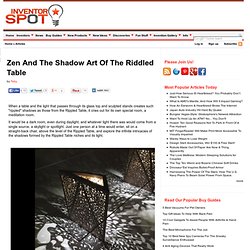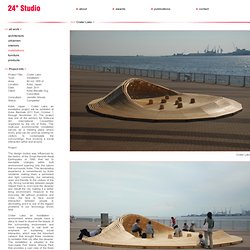

Google Image Result for. Rotating Stage - Automobile Turntable, revolving platform, Circular Turning Staging. Otto Piene’s ‘Light Ballet’ dazzles at MIT - Arts. LUMEN HAS GONE TO THE BIRDS. In case you didn’t see them when they came out this spring, Adam Frank‘s latest line of lumen lamps is not to be missed.

We fell instantly in love with his first version — a silhouette of a tree — and the new trio of bird designs sent us head-over-heels. All you do is light the little oil lamp and a shadow flock of birds erupts onto your wall. Adam Frank just generously donated a Lumen Flock to our Inhabitat reader survey giveaway, so if you take the survey now, one member of this flock could be yours… In Praise of Shadows. In Praise of Shadows (陰翳礼讃 , In'ei Raisan?) Is an essay on Japanese aesthetics by the Japanese author and novelist Jun'ichirō Tanizaki. It was translated into English by the academic students of Japanese literature Thomas Harper and Edward Seidensticker.
Publication[edit] The essay was originally published in 1933 in Japanese. The English translation was published in 1977 by Leete's Island Books.[1] The translation contains a foreword by architect and educator Charles Moore and an afterword by one of the translators, Thomas J. Much shorter than the author's novels, this book is a small meditative work of 73 pages, of which 59 are the essay itself. Themes[edit] The essay consists of 16 sections that discuss traditional Japanese aesthetics in contrast with change.
The text presents personal reflections on topics as diverse as architecture and its fittings, crafts, finishes, jade, food, cosmetics and mono no aware (the art of impermanence). Cultural notes[edit] Mono no aware. Mono no aware (物の哀れ?)

, literally "the pathos of things", and also translated as "an empathy toward things", or "a sensitivity to ephemera", is a Japanese term for the awareness of impermanence (無常, mujō?) , or transience of things, and both a transient gentle sadness (or wistfulness) at their passing as well as a longer, deeper gentle sadness about this state being the reality of life. Origins[edit] The term was coined in the 18th century by the Edo period Japanese cultural scholar Motoori Norinaga and was originally a concept used in his literary criticism of The Tale of Genji, later applied to other seminal Japanese works including the Man'yōshū.
It became central to his philosophy of literature and eventually to Japanese cultural tradition. Etymology[edit] The phrase is derived from the Japanese word mono (物?) In contemporary culture[edit] Zen And The Shadow Art Of The Riddled Table. When a table and the light that passes through its glass top and sculpted stands creates such "rippled" shadows as those from the Rippled Table, it cries out for its own special room, a meditation room.

It would be a dark room, even during daylight, and whatever light there was would come from a single source, a skylight or spotlight. Just one person at a time would enter, sit on a straight-back chair, above the level of the Rippled Table, and explore the infinite intricacies of the shadows formed by the Rippled Table niches and its light. Was meditation what American architect Stephen Holl had in mind when he created the Rippled Table? Perhaps. He is especially known for blending and bending light with the details of his architectural design but his architectural works are also admired for their spiritual qualities. Look at the difference in effects, now that the Rippled Table is shown in full photographic lighting. And again, photographed at an angle... source: Horm via 3Rings. Crater Lake, 24° STUDIO, Kobe Japan, 2011. Architecture, interior, furniture, and product design. Crater Lake Application Diagram Structural and Surface Plans Side and Front Elevations Part 2 Components Construction Matrix.

Office of the President: Excellence in Design. James Dart of the architecture faculty was honored for his design "Barn + Lath House.

" James Dart A.I.A., special lecturer in architecture, recently received a American Institute of Architects' 2002 Honor Award for his "Barn + Lath House" at Historic Bartram's Garden in Philadelphia. The AIA Honor Awards, the profession's highest recognition of excellence in design, best exemplify excellence in architecture, interiors, and urban design. The jury described the project as "an ingenious addition to an historic barn that creates interest by contrasting the assembled nature of the new with the monolithic quality of the old.
" The barn had seen many additions and alterations over the years. It had remained a working structure well into the 20th century, having been altered last in the 1920s. Revolving Stage, Automobile Rotation, Turning Platform. Inside Lath House Shadows. Google Image Result for. Sierra Greenhouse - Photo Gallery. Google Image Result for. Google Image Result for.